Holne Sweet Holne
By my reckoning, it had been far too long since our last visit to Holne. We had not long bought our first digital camera (a Fuji S100 FS) and arrived early in the morning to dawdle along (and mostly up) between the high-banked hedges Devon is famous for. The early bird catches the worm, or in this case, the waking moths and butterflies.
This time we approached Holne from a different angle: starting near enough from the top of Hembury Woods. Regrettably, it was much later than we had intended. But there was still much to note and many things for Sherry to photograph. It is often hard to whittle down the many shots to just a few. Among those that did not make the cut were marmalade hover flies and tachinid flies on hogweed flowers, and a ringlet butterfly we watched in the bracken. The veins in its wings really stood out and seemed to throb as if they would explode.
We continued along a long straight, stretch of road that I always associate with other, flatter parts of the country. It was the sort of road even the great Roman engineers might have baulked at and introduced the odd kink to lift those marching along it; the sort of road you could imagine funnelling into a void. With twists and turns and hills (however steep) it is easy to convince yourself that you are making progress. But with straight stretches, the emphasis shifts. It can seem you are going nowhere fast and that the road is laughing at you.
The thing to do is avoid the middle line (where there is little or no variation) and look to either side, where there is plenty. The average wild hedge can seem like a treasure trove at this time of year.
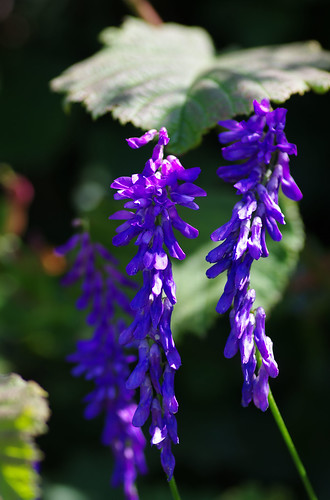
Tufted Vetch (Vicia cracca)
The tall spike of purple flowers help distinguish this species from its neighbours. Its formation is more like the yellow and white melilots.
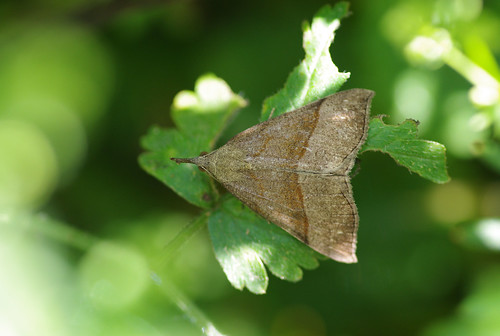
The Snout (Hypena proboscidalis)
Finding the answer to this species at home, I could not stop smiling. As well as having a poetic way with words, those discovering and naming moth species definitely had a sense of humour. Snouts are similar to fan-foots but generally brighter. I would love to see the rarer Paignton Snout (presumably named because it was recorded in Paignton.)
We had left our straight bit of road behind at this point. At Humphrey's Cross we went left and down a steepish lane.
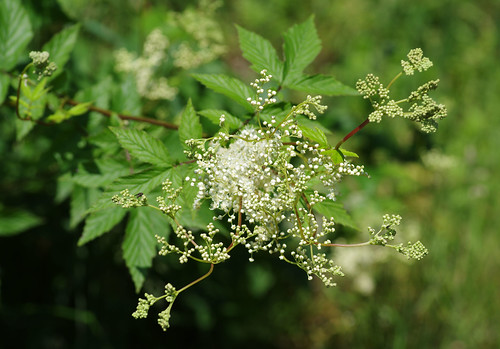
Meadowsweet (Filipendula ulmaria)
There was a stream at the bottom of the lane. Besides the Marsh Valerian flowers which looked too harsh, Sherry had considerably more success with this meadowsweet. This flower was said to be the favourite of Queen Elizabeth I. When the floors of rooms were covered with herbs and flowers to improve the smell and keep everything clean, meadowsweet was apparently strewn in her private chambers.
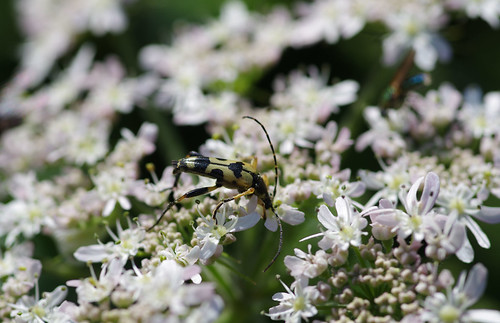
Strangalia maculata - not to be confused with the Wasp Beetle, which has much more black than yellow on its body.
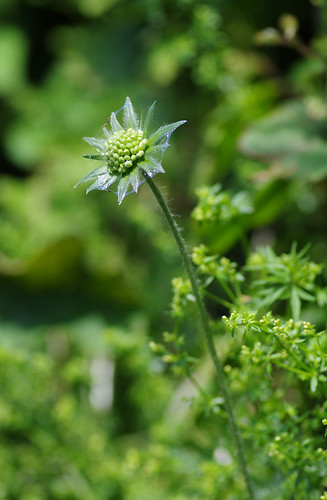
Field Scabious (Knautia arvensis)
Identifying plants can sometimes be difficult. But identifying plants before they come into flower can pose a real challenge.
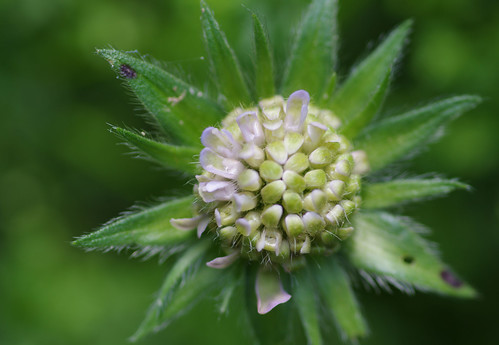
Close-up of buds and nascent petals
That said, I'm fairly sure that both the above shots are Field Scabious. The petals in the centre are just beginning to unfurl. Though this specimen was partly in the shade it was a warm day. If we had stayed in the same place long enough we might have witnessed the entire transformation from bud to flower.

Soft Lady's-mantle (Alchemilla mollis)
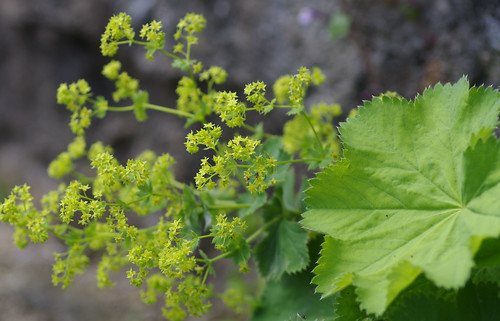
And a closer view
Lady's-mantles are another difficult one. There are several species but I have plumped for the smooth variety because:
a) it is common
b) the shape of the leaves
c) the number of petals on the flowers
Besides the ideal spot to have our lunch, we had a quick look around the graveyard to see what we could find.
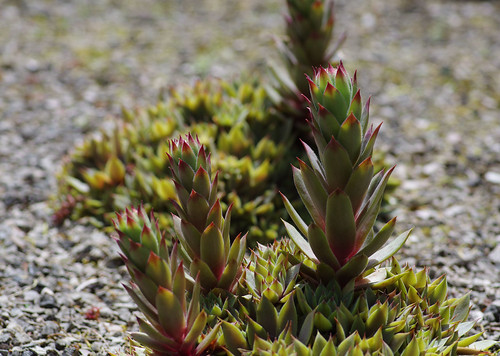
House-leek (Sempervirum tectorum)
Churchyards are a habitat we often overlook. Besides being peaceful places, there are flowers to be found like this house-leek: growing on the gravel of a grave.

Scaly Male-fern (Dryopteris affinis)
The spores (or sori, to give the more technical term) were kidney-shaped. When these spores are ripe they are said to be carcinogenic. I thought this was Male-fern at first but the pinnules (the bits at the side of each stem) of that species have pointed ends. These have small toothed indentations but are unpointed.
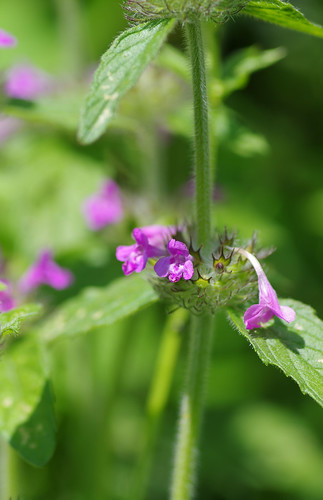
Flowering stem of Wild Basil (Clinopodium vulgare)

Pyrochroa serraticornis beetles mating
I asserted these to be Cardinal Beetles but later found out that Cardinals have exclusively black heads. The red-headed lovers above are an entirely different species.
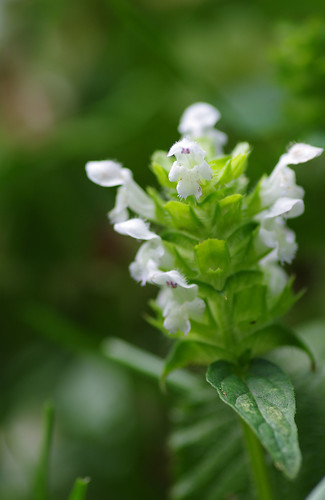

Two views of the white form of Self-heal (Prunella vulgaris)
After completing our walk, we made one last diversion before returning home. Briefly we wandered around the upper limits of Hembury Woods. I had never seen white self-heals before and again jumped to the wrong conclusion; thinking the white flowers we found were Cut-leaved self-heal (a species in its own right). You have to try and be rational when seeing something new, and try to keep a clear head. As Sherlock Holmes might have remarked to Dr Watson: 'You see but you do not observe.'
OUR ROUTE:
Follow the road intersecting Hembury Woods until you reach Humphrey's Cross. Turn left down the hill and follow it past the stream and up the hill past Shuttaford. Go straight ahead (bearing left slightly) at Ridgey Cross and follow road into Holne. In the village, there is a pub, general store and tea room.
Return leg
Back along same lane but at Ridgey Cross turn left and follow the bridleway. Gorse has overgrown the correct path and you will need to go around and rejoin the path further on. At the end, turn right along the road and then bear right again at Gallant Le Bower Cross. The road leads back to Hembury Woods, where you can explore the remains of an Iron Age fort and walk along a path alongside the River Dart in both directions until the boundary of the reserve.
Ordnance Survey Map needed: OL28 - DARTMOOR

Comments
Add a Comment